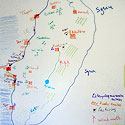October 2010
The Biggest Polluter

Each year Project Censored compiles a list of 25 urgent stories that are grossly underreported. But on this year’s chilling list, the scale of this one is just staggering:
“The US military is responsible for the most egregious and widespread pollution of the planet, yet this information and accompanying documentation goes almost entirely unreported. In spite of the evidence, the environmental impact of the US military goes largely unaddressed by environmental organizations and was not the focus of any discussions or proposed restrictions at the recent UN Climate Change Conference in Copenhagen. This impact includes uninhibited use of fossil fuels, massive creation of greenhouse gases, and extensive release of radioactive and chemical contaminants into the air, water, and soil.
The extensive global operations of the US military (wars, interventions, and secret operations on over one thousand bases around the world and six thousand facilities in the United States) are not counted against US greenhouse gas limits.…
As it stands, the Department of Defense is the largest polluter in the world, producing more hazardous waste than the five largest US chemical companies combined. Depleted uranium, petroleum, oil, pesticides, defoliant agents such as Agent Orange, and lead, along with vast amounts of radiation from weaponry produced, tested, and used, are just some of the pollutants with which the US military is contaminating the environment.”
The horror goes on and on and on.
And it makes me think a lot of sustainable designers may be fighting the wrong war.
 “Do you want a salad with that?” A powerful NY Times infographic on how shifting the default parameters of a space can motivate changes in behavior, in this case quietly altering lunch line layout and interaction to nudge kids into making healthier lunch choices. The graphic does a good job of calling out key data, and the data is astonishing, but lacks citation or context so here’s an article and a longer report by the authors which covers the same material in more depth.
“Do you want a salad with that?” A powerful NY Times infographic on how shifting the default parameters of a space can motivate changes in behavior, in this case quietly altering lunch line layout and interaction to nudge kids into making healthier lunch choices. The graphic does a good job of calling out key data, and the data is astonishing, but lacks citation or context so here’s an article and a longer report by the authors which covers the same material in more depth.Information Design for Advocacy: Beirut Workshops

Civil society in Lebanon is blossoming. The number of registered NGOs has increased dramatically in recent years and as advocacy campaigns become more sophisticated, there is a growing appetite for learning new techniques for conveying ones messages. I was invited by the US State Department Speaker Specialist Program to work with the Social Media Exchange (SMEX) in Beirut to conduct a week of workshops for local and international NGO staff on visual thinking and information design for advocacy.
Building on my work and my 2008 booklet Visualizing Information for Advocacy: An Introduction to Information Design, I devised three day-long workshops which were announced as follows:
Continue reading "Information Design for Advocacy: Beirut Workshops" »
Visualising Women’s Rights in the Arab World
I don’t usually blog about events, but I like how the model here approaches something of an incubator:
“A three day hands-on workshop (5 - 8 December 2010, in Jordan), for activists and NGOs in the Arab region, working on women’s rights, to explore how visual techniques can strengthen campaigning. The workshop will give participants the skills to plan and strategise visual campaigns, think about how to use information effectively and gain hands-on skills to develop a campaign using information design, mapping and animation/imaging techniques....
We invite applications for those working on women’s rights issues, in particular violence against women, the impact and role of women in political and violent conflict and women’s participation and leadership in public life. We also welcome communications specialists, designers, artists, illustrators, or technologists working with mapping techniques or data who can support women’s rights activists. 35 to 40 applicants will be selected to attend the launch workshop in Jordan in December. Participants will have to bring with them a campaign idea which will be developed over the course of three days. Of these, 10 campaigns will be provided with small-scale follow up support and mentoring to implement the visualisation element of their campaign in early 2011.”
They also have a project blog highlighting examples of visualisations. Applications to attend the workshop are due October 14, 2010.


